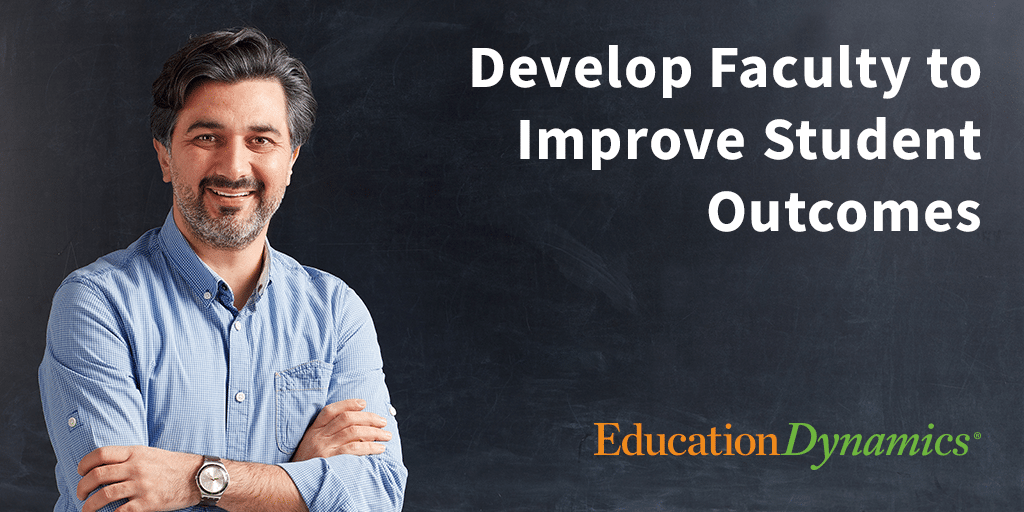Improve Faculty Development to Grow Enrollments and Graduation

To get better at something, you need to work at it. That principle is as true for your institution’s faculty as it is for the students they instruct. A thoughtful, yet flexible faculty development strategy gives instructors and professors the opportunity to excel.
More often than not, the people who choose to become teachers are curious and eager to learn. Giving them opportunities to do so improves outcomes for everyone involved. Here’s how: through development opportunities, faculty learn new skills and techniques. They employ these in their classrooms. Consequently, students learn more and see their professors as more competent. As a result, the faculty are happier, the students are happier, and your institution achieves higher retention, higher completion rates, and a better overall reputation. That makes your institution more attractive to prospective students.
Good faculty development goes beyond mandatory training or a yearly conference. By creating a thoughtful faculty development strategy, you give each faculty member the tools to be the most effective instructor they can be. Here are six ways you can improve faculty development at your institution.
1: Understand best practices
A study from the Learning Policy Institute found seven features that make any professional development program more effective they are:
- A focus on content
- Opportunities for active learning
- Collaboration on the job
- Modeling of effective practices
- Coaching and support from experts
- Opportunities for reflection and feedback
- Delivery over time
By checking each development opportunity and your overall strategy against these metrics, you can choose opportunities that offer the best return on investment. You should also pay careful attention to what instructors need, and what they want, to make every development opportunity count.
2: Play the long game
As element seven above suggests, faculty development is a long-term strategy. You may see an initial spike in competence around a particular area after a training program. But, the faculty member doesn’t forget what they learned six months or six years later. They’re likely to still be applying and improving their knowledge months and years after the initial training.
Each training, each seminar, each opportunity to develop is like adding a brick to the house of faculty knowledge. Faculty members stack these bricks together to create something more valuable than the sum of its parts. It takes time. The initial training may serve as a foundation for faculty members to build on.
The takeaway: When planning your faculty development strategy, consider how this semester’s training compliments last semester. How does it all fit together to improve faculty skills?
3: Encourage informal, self-directed development
Teachers and professors who seek out learning opportunities often show the largest improvement. This makes sense because eager learners are the best learners. By encouraging informal, self-directed development, you give teachers the empower to take responsibility for their own development. Since each instructor has different students and different challenges, it’s important to give them the freedom to explore the solutions they need.
Instructors may seek out methods of learning that you would never have thought of. For example, many teachers are turning to Twitter to get advice and interact with other instructors. The platform allows them to expand their personal learning networks and gain exposure to diverse voices.
The takeaway: Support professors who want to go to a conference, bring a trainer to campus, or investigate a new teaching tool. Don’t discount the value of modern or non-traditional techniques.
4: Facilitate innovation
Faculty will only put new ideas into practice if you create an environment where innovation and experimentation are valued. Faculty should feel free to test new teaching technologies and modalities. If something doesn’t work as well as they hoped, they should have the freedom to abandon a strategy or try something new.
At the same time, don’t get so caught up in innovation that you force instructors to move away from proven, effective strategies and technologies. Innovation for its own sake is not as important as student learning outcomes. If an older strategy works well and an instructor is comfortable with it, they should be allowed to keep using it.
The takeaway: Make it clear through policies and communication that learning to be a better faculty member is a key element of the job description, but don’t confuse new with better.
5: Share the Knowledge
Faculty knowledge can become siloed. Faculty in the School of Liberal Arts may have a useful process or effective strategy that the School of Engineering has never heard of. Encouraging interaction between the two schools can make both more effective, improving your institution as a whole.
The same can be said of established instructors and new hires. New hires may have different ways of learning and teaching. Encouraging new hires to work with tenured professors enables both groups to explore new ways of thinking. Formal mentorship programs or informal coffee chats can facilitate these types of connections.
The takeaway: Encourage sharing and collaboration rather than competition between different schools or departments within your institution.
6: Consider the needs of online faculty
With more students embracing online learning, faculty members may need to build new skills appropriate for online programs. Online teaching requires a slightly different skill-set than traditional classroom instruction. In some cases, an institution may have faculty that teach only online. It’s especially important in this case to provide training on the history, values, and mission of the institution so that instructors feel like a part of the organization. In this way, they become good ambassadors of your programs.
The takeaway: To help all faculty members remain effective, institutions should provide training in the technological as well as the pedagogical aspects of the job.
The end result
Continuous faculty development keeps your institution fresh and your faculty engaged. Well-trained faculty leads to a better student experience, a better institutional reputation and, ultimately, higher enrollments.